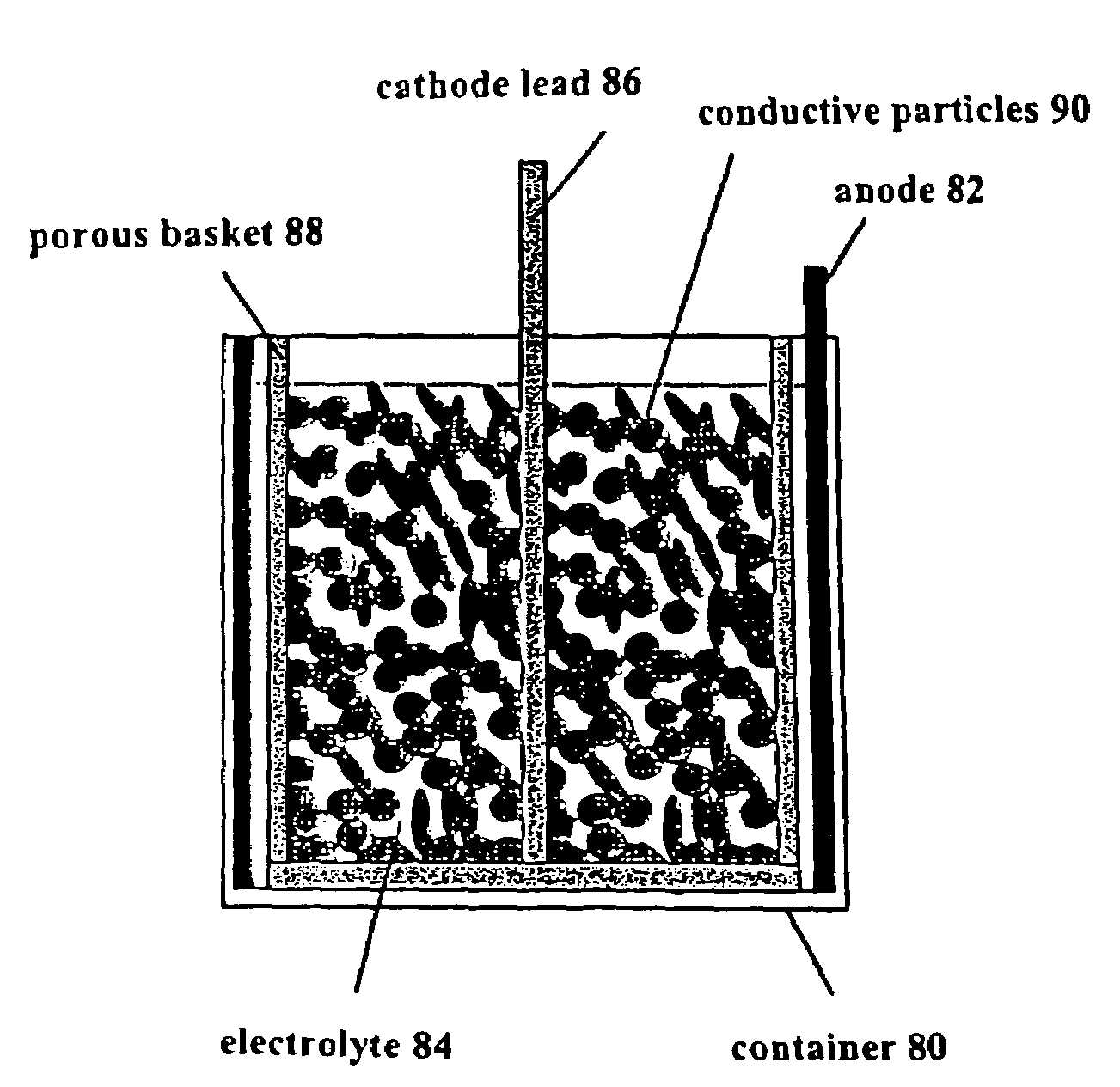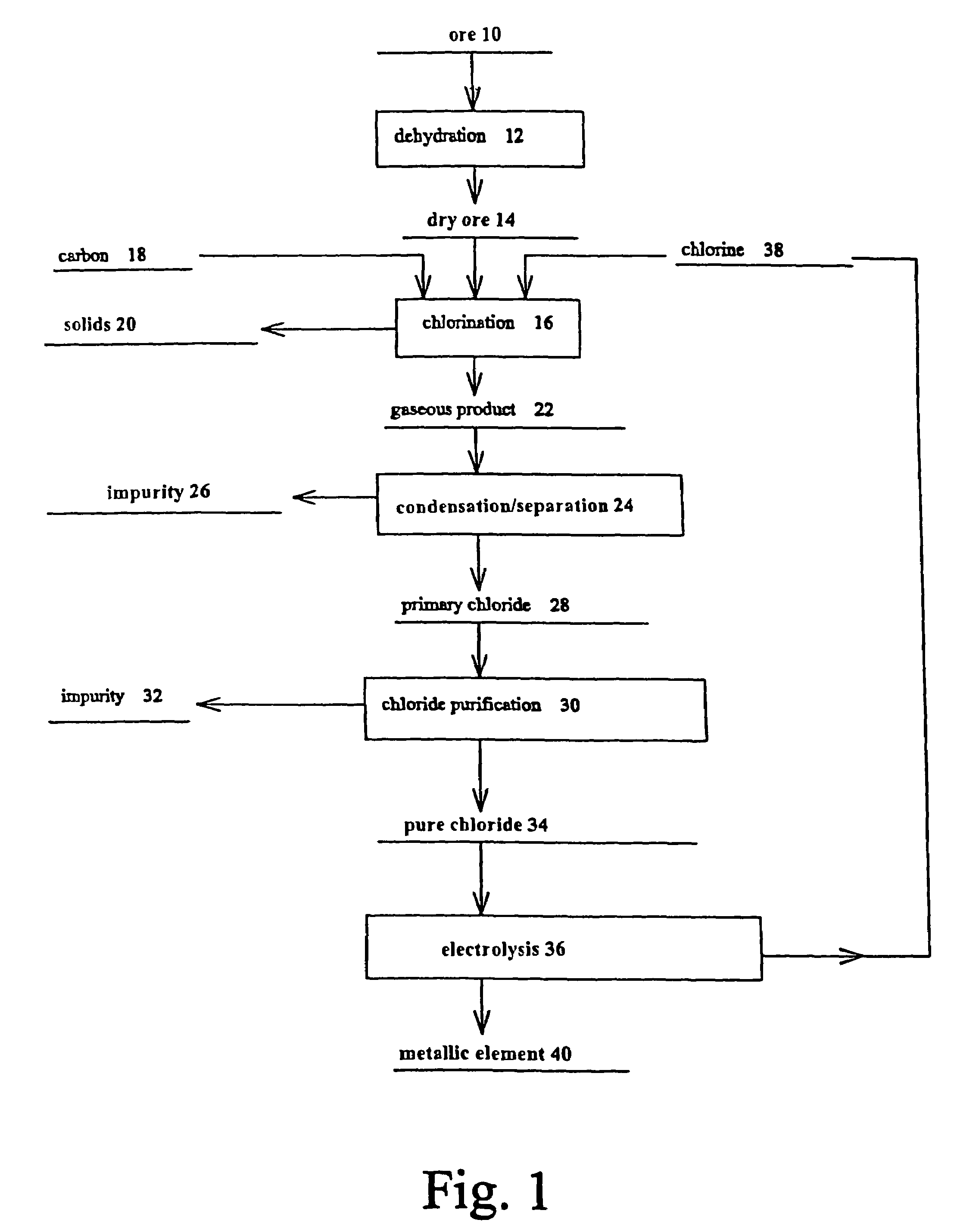Production, refining and recycling of lightweight and reactive metals in ionic liquids
a technology of reactive metals and ionic liquids, which is applied in the field of metal production and purification, can solve the problems of reducing the efficiency of ionic liquids, and reducing the cost and pollutant emission of conventional high temperature electrolysis processes, so as to reduce electrical energy costs, prevent some gaseous pollutant emissions, and reduce the effect of cost and pollutant emission
- Summary
- Abstract
- Description
- Claims
- Application Information
AI Technical Summary
Benefits of technology
Problems solved by technology
Method used
Image
Examples
example 1
Production of Al from Alumina
[0044]To extract aluminum from alumina, a mixture of alumina powder and graphite powder is first prepared. The mixture is heated above 200° C. Cl2 gas is passed through a fluidized bed of the hot mixture producing AlCl3 and CO2 gases. The AlCl3 gas is condensed and purified. An electrolyte containing the purified AlCl3 and BmimCl in a molar ratio of AlCl3 to BmimCl of 1.5 is prepared. A copper anode and a copper cathode are introduced into the electrolyte. The electrolyte is maintained at a temperature of 105° C. Application of a voltage of 3.0-3.4 V across the anode and cathode causes Al to electrodeposit on the cathode. FIG. 4 shows the Al deposited on the copper cathode. FIG. 5 shows an X-ray diffraction pattern of the copper cathode with the Al deposit.
[0045]Current industrial production of Al is by electrolysis of alumina dissolved in molten cryolite (Na3AlF6). The electrolytic cells operate at around 1000° C. Table I compares typical experimental c...
example 2
Purification of Al Alloy
[0047]An anode was prepared for electrorefining. The anode had the composition shown in Table 2.
[0048]
TABLE 2Composition of impure aluminum anodeElementAtomic %Al79.77Si11.62Fe0.758Cu5.00Mn0.187Mg0.0619Cr0.0461Ni0.0784Zn2.32Pb0.0713
[0049]The anode and a copper cathode were weighed and positioned about 2 cm apart in an 50 ml beaker on a hot plate stirrer. An electrolyte of anhydrous AlCl3 and BmimCl was weighed and mixed in the beaker under an inert atmosphere to avoid moisture. The molar ratio of anhydrous AlCl3 to BmimCl was 1.5. Stirring and heating rates were set. When electrolyte temperature was stable at 105° C., a constant cell voltage of 1.0-1.5 volts was applied between anode and cathode, and Al was electrodeposited at the cathode. After the electrolysis, the anode and cathode are taken out of the cell, washed with water and weighed again to measure the respective loss and gain. The anode and cathode were characterized using a micro image analyzer, X-...
example 3
Electrolyte Containing 1-butyl-3-methylimidazolium chloride
[0053]Electrolytes were made by mixing 0.17 moles of AlCl3 and 0.11 moles of 1-butyl-3-methylimidazolium chloride. An anode and a cathode were placed in the electrolyte. The electrolyte was heated to 100° C. A voltage of 1.5 volts was applied across the anode and cathode. Remarkably, electrodeposition of Al was only observed using a 1-butyl-3-methylimidazolium chloride-AlCl3 ionic liquid. Continuous electrodeposition of Al was not observed using other ionic liquids.
PUM
| Property | Measurement | Unit |
|---|---|---|
| voltage | aaaaa | aaaaa |
| voltage | aaaaa | aaaaa |
| temperature | aaaaa | aaaaa |
Abstract
Description
Claims
Application Information
 Login to View More
Login to View More - R&D
- Intellectual Property
- Life Sciences
- Materials
- Tech Scout
- Unparalleled Data Quality
- Higher Quality Content
- 60% Fewer Hallucinations
Browse by: Latest US Patents, China's latest patents, Technical Efficacy Thesaurus, Application Domain, Technology Topic, Popular Technical Reports.
© 2025 PatSnap. All rights reserved.Legal|Privacy policy|Modern Slavery Act Transparency Statement|Sitemap|About US| Contact US: help@patsnap.com



